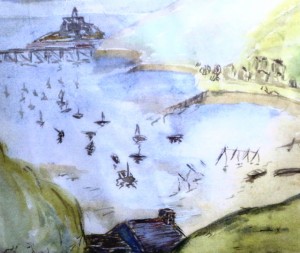
Swansea Bay (Eva Davies)
The arthouse cinema near where I live shows It’s a Wonderful Life every Christmas Eve. You can’t get in, unless you book within the hour back in August, or something like that.
I have my personal seasonal TV favorite. It’s the West Wing episode set in the days before Christmas, where Toby Ziegler arranges a full military funeral for a vagrant Vietnam veteran who dies of cold in Washington DC.
Nobody ever has to miss the biggest seasonal screen phenomenon of all, The Snowman, first shown in 1982. And this year (2012) Channel 4 screens a new animated film in the style of the 30-year-old favourite, The Snowman and the Snowdog, sparing little expense on the production.
So why is the other perennial story of the season not brought back year after year? A Child’s Christmas in Wales has all the necessary ingredients – snow, carols, anticipation, robins, presents, Christmas afternoon slumber, and deep nostalgia. Yet it’s never managed to attach itself permanently to the schedules.
In part this is because the few TV adaptations that have been made were never particularly good, and would look terribly dated today. Contrast that with the timeless and quite brilliant piece of animation that is the Snowman.
What if it had been filmed well, because movies of quality don’t date? Christmas on 34th Street (the first version) and It’s a Wonderful Life are old only in the sense that Bing Crosby singing White Christmas and Eartha Kitt in shamelessly suggestive mode doing Santa Baby are similarly tired and dated.
I think the problem with the A Child’s Christmas is that we have to supply the images. Thomas was the consummate radio broadcaster. We should rejoice that Barbara Holdridge and Marianne Roney had the foresight to record him reading the story, I should mention, too, that artist Edward Ardizzone did some wonderful illustrations for one version of the book.
There is too much of Dylan Thomas’ imagination for this book (or long short story) for it to work in the visual sense, although, in reality, the only real fantasy element is all that snow at Christmas. I was born in Swansea and grew up nearby, and I can assure you, even in that bitter winter of 1963, it’s never snowed at Christmas.
The story is much less, in truth, about Swansea than The Snowman is about Brighton. There are very few references to Wales. Will there be wolves? Well, that was a long time ago. The Christmas Day family rituals may be a little theatrical, but I never thought uncles trying out cigars and aunties quaffing a surreptitious sherry were particularly Welsh indulgences. And the moment when the old man joins in with the boys’ Christmas carols in a thin voice from behind the door is a brilliant and moving piece of childhood terror.
Still, it’s perfectly possible to reconstruct the story in your mind’s eye on a visit to Swansea, on the steeply sloping Cwmdonkin Drive, where, at number five, Thomas was born and lived until he was 20. Those two young men with the pipes could easily have walked down this hill until they reach the sea and they disappear under the waves, with only the pipes left floating.
The street, and Thomas’ family house, haven’t changed much since he was here. For the past few years, it has been possible to book the house itself for a stay over Christmas, and obtain the most precious insight of all into the writer’s complex mind and what we might consider to be his most accessible creation.
Quite shortly, in 2014, the centenary of his birth, we will be reassessing Thomas’ brief life, flawed self-destructive personality and brilliant creativity. My feeling is that the Welsh, and Swansea people felt Thomas had overstepped the mark, too often, and, as an itinerate and often drunken reprobate, had turned his back on them. The manner of his passing, in 1953, would have offended against a still rather strict moral code. At the same time he was lionized elsewhere, and is now widely accepted as one of the great literary talents, writing in the English language, of the 20th century. It was, after all, President Jimmy Carter who opened the Dylan Thomas Centre in Swansea.
Is it not time to welcome back the prodigal son to his home “ugly, lovely” town? As he said, “crawling, sprawling … by the side of a long and splendid curving shore. This sea-town was my world.”
See also.
* In December 2012 the poet received a notable piece of posthumus recognition when HRH The Prince of Wales took tea (and Welsh cakes) in the front parlour of 5, Cwmdonkin Drive. The announcement that the Prince was to become the royal patron of DT100, marking the centenary of the birth of Thomas, was made while he was at the house.
